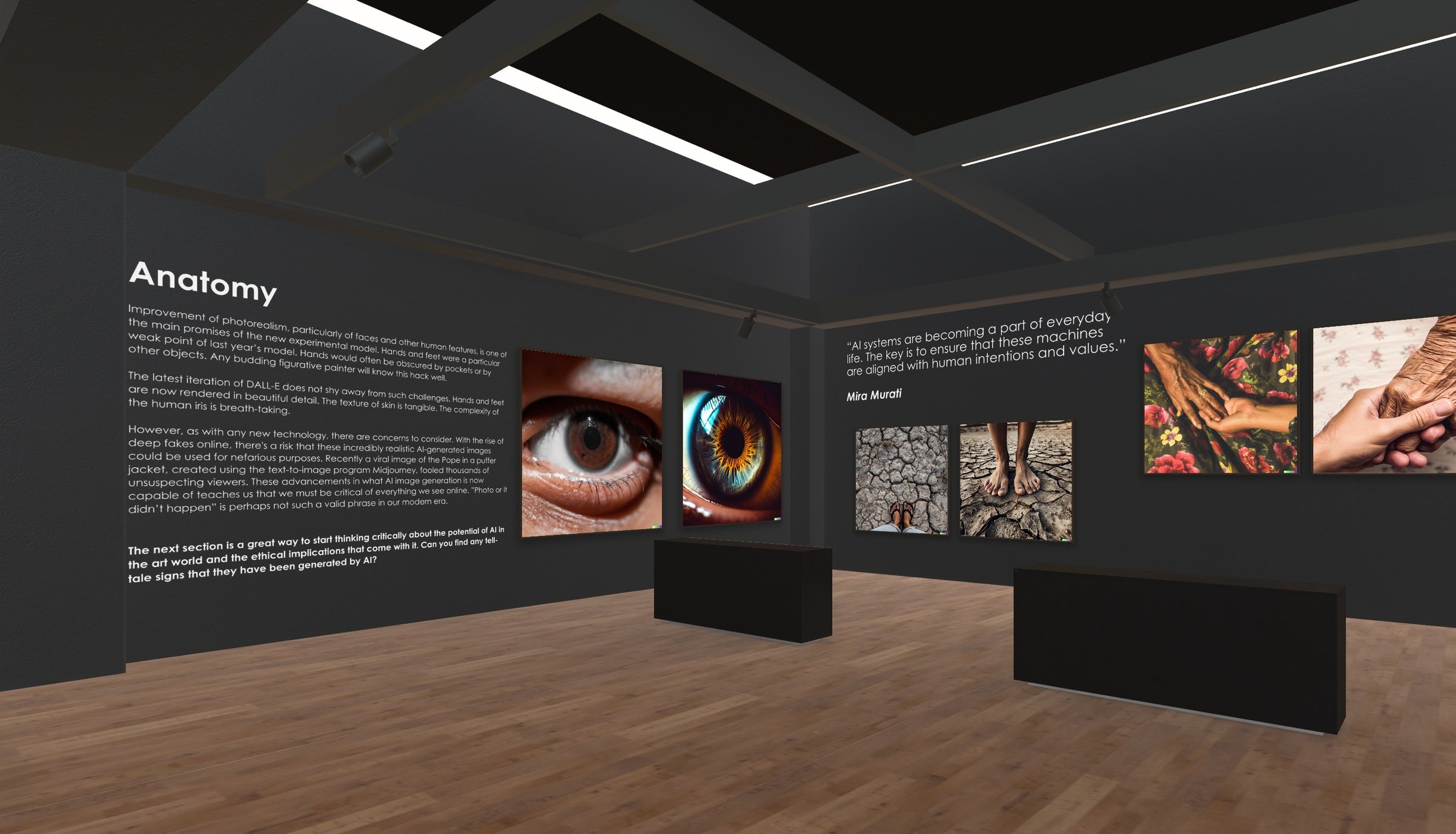

Anatomy
Improvement in photorealism, particularly of face and other human features, is one of the main promises of the new experimental model. Hands and feet were a particular weak point of last year’s model. Hands would often be obscured by pockets or by other objects. Any budding figurative painter will know this hack well.
The latest iteration of DALL-E does not shy away from such challenges. Hands and feet are now rendered in beautiful detail. The texture of skin is tangible. The complexity of the human iris is breath-taking.
However, as with any new technology, there are concerns to consider. With the rise of deep fakes online, there’s a risk that these incredibly realist AI generated images could be used for nefarious purposes. Recently a viral image of the Pope in a puffer jacker, created using the text-to-image- program Midjourney, fooled thousands of unsuspecting viewers. These advancements in AI image generation is now capable of teaches us that we must be critical of everything we see online. “Photo or it didn’t happen” is perhaps not such a valid phrase for our modern era.
The next section is a great way to start thinking critically about the potential of AI in the art world and the ethical implications that come with it. Can you find any tell-tale signs that they have been generated by AI?
The Human Eye - The photorealism in this image is remarkable considering that this wasn't the forte of the 2022 model. The shading and subtle highlights illuminate the texture of the skin making it sufficiently lifelike but the iris is lacking detail. Before examining the next image, take a moment to look into someone's eye or grab yourself a mirror and see how much anatomical detail has been missed. There is even lens blur in the image which highlights the subject of the composition - the human eye. Prompt: A close up photograph of a human eye Model: DALL-E v2.0 (2022)
The Human Eye - The 2023 model has truly taken fine detail to the next level. The contrast of the image and the saturation of the colours is instantly striking making for a more artistic composition. The fine annular pattern of muscles in the iris and the capillaries in the sclera are clearly visible making this image eerily lifelike. From this image it is clear to see why our irises are as unique to us as our fingerprints. Prompt: A close up photograph of a human eye Model: DALL-E v2.exp (2023)
Feet Anatomy - This image has a fascinating juxtaposition that highlights a significant weakness of the 2022 model. The human anatomy of the feet depicted in this piece fall short of the desired level of realism. However, the model compensates for this flaw by rendering the cracks in the dried mud with remarkable believability, leading the viewer's gaze towards the two sandalled feet. While some may appreciate the pleasing painterly style in which the feet are represented, it is worth noting that the prompt called for an 8K photograph, indicating a preference for high-quality photorealism. In this regard, the artist has not fully met the expectations of the prompt. The flaws in the piece add an element of intrigue, prompting further examination and interpretation by the viewer. Prompt: A close up thought-provoking environmental photo of a persons feet that conveys the impact of humanity on our planet. The subject is standing in a barren landscape. 8K photograph. Model: DALL-E v2.0 (2022)
Feet Anatomy - The contrast in quality between this piece and its predecessor is spectacular. The human feet in this artwork are much more anatomically precise, lending a sense of realism that was previously absent. The overall image now achieves the intended vision of the prompt with great success. The use of lens blur draws the viewer's eye to the focal point of the piece, allowing one to reflect on the barren landscape and its potential origin. However, keen observers may notice a subtle detail that hints at the possibility of non-human involvement in the creation of this piece. Prompt: A close up thought-provoking environmental photo of a persons feet that conveys the impact of humanity on our planet. The subject is standing in a barren landscape. 8K photograph. Model: DALL-E v2.exp (2023)
Holding Hands - The image here highlights that hands could be rendered by the earlier model from 2022 but it was definitely a weak point, like any budding artist. The folds in the floral drapery have been executed well but the anatomy is not quite believable. Prompt: close up image of a young person holding an old persons hand diagonally across the image with a light floral fabric background dramatic lighting. Model: DALL-E v2.0 (2022)
Holding Hands - The floral fabric background isn't as visually interesting in the 2023 image but there is a stark contrast in how the hands have been portrayed. The detail is astounding. You can almost feel the texture of the older person's skin. The image has really capture the artist's intent creating a sense of a loving interaction between a young person and an elderly relative. Prompt: close up image of a young person holding an old persons hand diagonally across the image with a light floral fabric background dramatic lighting. Model: DALL-E v2.Exp (2023)
Deep in Thought - This paired of images, while aesthetically divergent, each carry a distinct beauty and charm. In the first, the level of photorealism achieved in the depiction of the face is notably impressive, especially considering it's a product of the previous generation of DALL-E. The subtle interplay of light and shadow serves to soothe the viewer, adding to the pensiveness of the figure's look. The bokeh background in this portrait, rather than serving as mere backdrop, acts as a complementary element. It harmonises with the soft, nuanced lighting, elevating the photograph beyond the realm of mere portraiture into a broader exploration of mood and aesthetics. Prompt: a chiaroscuro profile portrait. The subject is looking pensive and is mixed race and feminine. The lighting is dramatic with a bokeh landscape background. Model: DALL-E v2.0 (2022)
Deep in Thought - The lighting in this photographic portrait is both audacious and dynamic. The play of light and shadow over the protagonist's face dramatically reveals a thoughtful gaze cast into the distance, evoking an air of contemplation. The transition from photorealistic facial features to a more painterly depiction of the neck and shoulders is an intriguing stylistic choice, stimulating curiosity while skilfully redirecting our attention back to the introspective facial expression. The bokeh background, while not particularly engaging in its own right, serves a supportive role, subtly amplifying the overall composition rather than distracting from it. In totality, the beauty of the portrait, characterised by its striking lighting and composition, more than compensates for the understated backdrop. Prompt: a chiaroscuro profile portrait. The subject is looking pensive and is mixed race and feminine. The lighting is dramatic with a bokeh landscape background. Model: DALL-E v2.Exp (2023)









